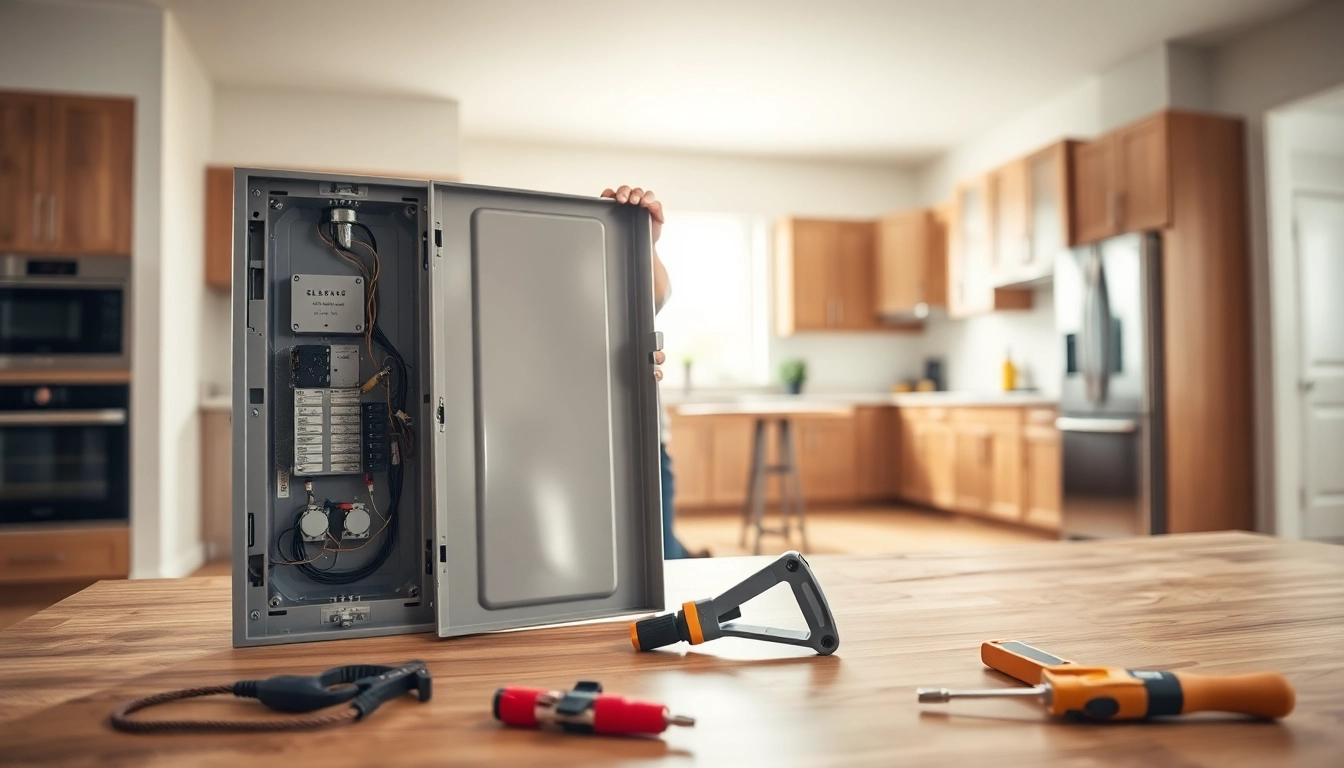What is an Electrical Panel Upgrade?
Definition and Purpose of an Electrical Panel
An electrical panel, also referred to as a breaker panel or service panel, is a critical component of your home’s electrical system. Essentially, it serves as the control center that distributes electrical power throughout your residence. The panel houses circuit breakers or fuses, which cut off power in the event of an overload or short circuit, thereby protecting your home from electrical hazards.
The primary purpose of an Electrical Panel Upgrade is to ensure that the electrical system can meet today’s demands, including safety codes and increasing usage of appliances. Over time, older panels may become inadequate, leading to potential safety risks or inefficiencies in power distribution.
Signs You May Need an Electrical Panel Upgrade
Recognizing the signs that indicate a need for an electrical panel upgrade is crucial for maintaining a safe and efficient electrical system. Common indicators include:
- Frequent Tripping of Circuit Breakers: If your circuit breakers trip often, it suggests that the current demand is exceeding what your panel can handle.
- Flickering Lights: Lights flickering or dimming during heavy appliance usage can indicate an overloaded panel.
- Multiple Extension Cords or Power Strips: Relying heavily on extension cords or power strips often points to insufficient outlets or circuits.
- Old or Damaged Panel: If your panel is over 20 years old, or shows signs of rust, burn marks, or damage, an upgrade may be necessary.
- New Appliances or Renovations: Installing high-demand appliances (like electric vehicles or HVAC systems) often necessitates a panel upgrade to accommodate their power needs.
Benefits of Upgrading Your Electrical Panel
Upgrading your electrical panel offers numerous advantages, including:
- Increased Capacity: A new panel can handle more amps, accommodating additional circuits for modern appliances.
- Enhanced Safety: Modern panels come equipped with improved safety features to reduce risks of electrical fires and hazards.
- Increased Property Value: A contemporary electrical system is attractive to buyers and can increase your home’s market value.
- Better Energy Efficiency: Upgrading can lead to reduced energy costs, as newer panels distribute power more efficiently.
- Compliance with Code: New panels are built to meet the latest safety codes and regulations, which is particularly important during real estate transactions.
Common Electrical Panel Upgrade Scenarios
Residential Upgrades: When to Consider a Change
Homeowners often decide to upgrade their electrical panels in response to changing needs. Common scenarios include:
- Home Expansion: If you’re adding onto your home, such as building an addition or renovating an area, your electrical needs may exceed your current panel’s capacity.
- Increased Electricity Demand: With the rise of smart devices, energy-efficient appliances, and home entertainment systems, homes require more power than ever.
- Age of the Existing Panel: Older homes may still have outdated panels, such as Federal Pacific or Zinsco, which can pose safety risks.
Commercial Electrical Panel Upgrade Needs
In commercial settings, the need for electrical panel upgrades can also arise. Factors include:
- Increased Load Requirements: New equipment and machinery often demand more power, necessitating a review of existing panels.
- Compliance with Upgraded Codes: Regulations for commercial electrical systems are more stringent, and existing systems may not meet current codes.
- Enhanced Safety Regulations: Upgrading protects business operations and employee safety.
Specialized Upgrades for Electric Vehicle Charging
As electric vehicle (EV) use rises, many homeowners are discovering that their existing electrical panels cannot support the high-amperage chargers used for these cars. An upgrade may be necessary in scenarios such as:
- The Installation of Level 2 Chargers: These chargers require significantly more power than standard outlets, usually necessitating a panel upgrade.
- Future-Proofing for Additional EVs: Planning for potentially more than one EV in the household will require robust electrical infrastructure.
Estimating the Costs of Electrical Panel Upgrades
Typical Cost Ranges and Factors Affecting Pricing
The cost of upgrading an electrical panel varies substantially based on multiple factors, including:
- Panel Size: Upgrading from a 100-amp to a 200-amp panel typically ranges from $1,300 to $3,000, depending on location and specific job complexity.
- Labor Costs: Hiring a qualified electrician can significantly affect the overall cost, with hourly rates usually varying from $50 to $150.
- Permits and Inspections: Local regulations may require permits and inspections, adding to the overall cost.
- Additional Wiring or Components: If additional electrical work is needed (e.g., new circuits or connections), this will further increase costs.
Comparing DIY vs Professional Installation Costs
While some homeowners might consider a DIY electrical panel upgrade, this is not recommended due to the risks involved. Professional installation is often more cost-effective in the long run because:
- Safety: Electricians have the expertise to handle high-voltage work, minimizing risks of accidents or injuries.
- Compliance with Codes: Electricians ensure that work is up to code, avoiding potentially costly fines or insurance issues down the line.
- Warranty and Insurance: Professional work typically comes with warranties and protection against future problems.
Understanding Potential Rebates and Tax Credits
Homeowners may be eligible for rebates or tax credits when upgrading their electrical panels, particularly in relation to energy efficiency initiatives. Some important considerations include:
- Local Utility Rebates: Many utility companies offer rebates for energy upgrades, including electrical panel replacements designed to enhance efficiency.
- Federal Tax Credits: As part of federal energy-saving programs, homeowners may claim a tax credit up to $2,000 for qualifying electrical upgrades.
- Consult Local Resources: Consult your local government or utility company to identify available incentives tailored to electrical panel upgrades.
Steps for Planning Your Electrical Panel Upgrade
Assessing Your Current Electrical Needs
The first step in planning your electrical panel upgrade is assessing your current and future power needs. Follow these steps:
- Inventory Your Appliances: List all major appliances and their power requirements to determine your total load.
- Consider Future Energy Loads: Plan for future additions, such as EV chargers or expanded HVAC units.
- Consult with a Professional: Engaging an electrician can provide insights into current code requirements and your specific needs.
Choosing the Right Panel and Hardware
When selecting an electrical panel, consider factors like:
- Amperage Rating: Ensure the panel can handle both your current and anticipated electrical loads (typically 200 amps for modern homes).
- Type of Panel: There are various types of panels like main panels, subpanels, and smart panels, each suited for different needs.
- Brand and Quality: Opt for reputable manufacturers known for reliability and safety.
Hiring a Qualified Electrician: What to Look For
Hiring the right electrician is essential for a successful upgrade. Look for the following:
- Licensing and Insurance: Ensure the electrician is licensed and insured to protect yourself from liability.
- Experience: Look for electricians with specific experience in panel upgrades and who can provide references.
- Clear Quotes: Get detailed quotes that outline all costs, including labor, materials, and potential additional charges.
Safety Considerations and Best Practices
Regulatory Codes and Permits for Electrical Upgrades
Before any upgrade, be sure to check local codes and obtain necessary permits. Compliance ensures safety, mitigates legal risks, and contributes to a more robust electrical system. Key considerations include:
- National Electrical Code (NEC): Ensure that upgrades meet NEC standards to guarantee safety and practicality.
- Local Codes: Each area may have specific codes which can vary significantly. Check with local authorities.
- Inspection Requirements: Many jurisdictions require final inspections after the work is complete to ensure compliance.
Safety Tips During and After the Upgrade Process
Safety should be a priority before, during, and after an electrical panel upgrade:
- Power Down: Make sure the power is turned off at the main service before any work begins.
- Use Proper Safety Gear: When working with electrical components, wear safety gloves and goggles.
- Avoid DIY: Unless you have training in electrical work, hiring a professional is the safest option.
Maintaining Your Electrical System Post-Upgrade
Once the upgrade is complete, regular maintenance will help keep your system running safely and efficiently. Consider the following:
- Regular Inspections: Schedule inspections at least once every few years to identify any potential issues.
- Watch for Warning Signs: Be vigilant for any flickering lights, tripping breakers, or outlets that feel warm to the touch.
- Stay Informed: Keep yourself updated on current safety codes and practices to maintain compliance.



